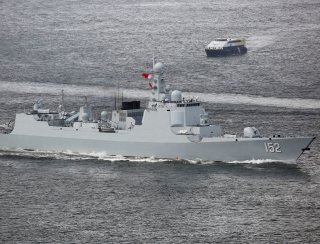Double the Destroyers: China Will Soon Have Almost 40 of These Modern Warships
Can America keep up with China's ambitious and speedy ship-building?
The Chinese Navy may double its fleet of destroyers in just the next five years, bringing increased reach, firepower and missile defenses to new areas around the globe.
The People’s Liberation Army Navy, which now fields twenty destroyers, is expected to operate as many as thirty-nine of the warships within five years, a move which massively expands the attack reach of the Chinese Navy.
“As of mid-2020, the PLAN currently fields 20 modern aegis-type* destroyers in its order of battle, supported by another 11 older, non-aegis-type destroyers. These 20 modern aegis-type destroyers are made up of six Type 052Cs, 13 Type 052Ds, and one lead Type 055,” a story in The Diplomat writes.
The increase in destroyers parallels a much larger Chinese Naval expansion now causing concern among Pentagon leaders.
A recent Congressional report maps out China’s ambitious aircraft carrier modernization plan. Citing that the Chinese Navy, now having 360 ships, has already well surpassed the U.S. Navy’s 297 ships in terms of sheer size.
Having already launched its second carrier, the Shangdong, the Chinese have embarked upon the construction of a newer, far-more capable third aircraft carrier, according to a May 2020 Congressional Research Service Report, “China Naval Modernization: Implications for U.S. Navy Capabilities.”
The People’s Liberation Army Navy, a report in The Diplomat says, will likely have 400 ships and at three-to-four aircraft carriers by 2025.
Following the construction of its first indigenously-built carrier, the second carrier in the fleet overall, modeled after its ski-jump-configured Ukrainian-built Liaoning, the PLAN has embarked upon a larger, flatter, more modern carrier platform with smooth, longer-range electromagnetic catapults similar to the U.S. Ford-class.
An electromagnetic catapult generates a fluid, smooth launch, which is different than a steam-powered “shotgun” type take off. Also, an electromagnetic catapult extends an attack envelope well beyond what China’s existing ski jump launch makes possible.
China’s emerging Type 055 destroyer is also attracting attention from U.S. planners. Interestingly, the ship represents an apparent Chinese effort to build a stealthy destroyer.
The ship has a blended body-bow, smooth exterior, absence of large protruding deck masts and few external deck-mounted weapons. In some respects, the ship does appear to resemble some elements of the U.S. Navy’s stealthy USS Zumwalt destroyer.
The Nanchang has very similar-looking deck-mounted guns and a smooth, flat, roundly curved deckhouse. Like the USS Zumwalt, there is a decidedly linear, inwardly-angled hull-deckhouse connection.
It has narrow command post windows and appears to mirror the hull deckhouse configuration of the USS Zumwalt to some extent with radar panels blended into sides of the ship.
Also, the central placement of the deckhouse, blended with a back end area, might represent a deliberate effort to align the ship’s center of gravity and therefore decrease the possibility of capsizing in rough seas.
Some of the ship’s stealth features were pointed out in a 2018 story in The Diplomat, which describes the ship as having a “flared hull with distinctly stealthy features including an enclosed bow,” and hidden mooring points and anchor chains.
This deck structure indeed does reveal an apparent attempt to engineer a ship with a lower radar signature, as there are no externally mounted, angular or protruding weapons systems hanging from the sides of the ship.
There are few separated large, pointy antenna masts apart from one aligned straight up on top of the deckhouse and a small cluster on the back end.
However, unlike the USS Zumwalt, which aligns VLS (Vertical Launch Systems) along the periphery of the ship deck, the Diplomat describes the Type 055 destroyers as having a “64 cell block of VLS.” More concentrated VLS might seem to leave a ship more vulnerable to catastrophic attack should an incoming weapon hit the centralized group of VLS.
Having VLS on the periphery, however, would enable many VLS to sustain functionality in the event that some were disabled or destroyed by enemy attacks. Also, closely stacked VLS would emit a larger heat signature should multiple missiles be launched concurrently.
Kris Osborn is the defense editor for the National Interest. Osborn previously served at the Pentagon as a Highly Qualified Expert with the Office of the Assistant Secretary of the Army—Acquisition, Logistics & Technology. Osborn has also worked as an anchor and on-air military specialist at national TV networks. He has appeared as a guest military expert on Fox News, MSNBC, The Military Channel, and The History Channel. He also has a Masters Degree in Comparative Literature from Columbia University.
Image: Reuters

